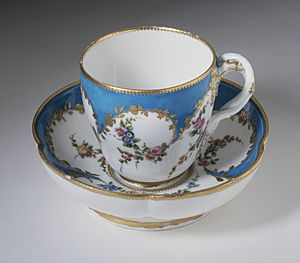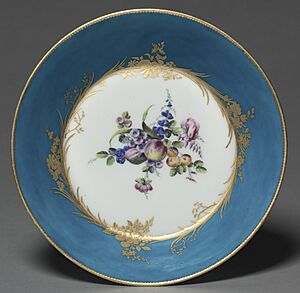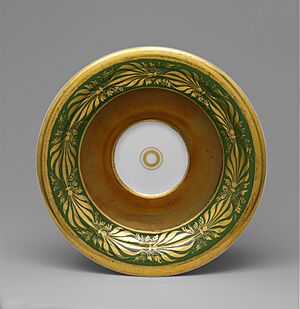Saucer facts for kids
A saucer is a small, flat plate or shallow bowl. It is usually placed under a cup, especially when you are drinking tea or coffee. Long ago, in the Middle Ages, saucers were used to hold condiments like spices or sauces. But today, they are mostly known as the little plate that goes with your teacup or coffee cup.
Why We Use Saucers
Saucers are very helpful! They have a few important jobs:
- Protecting surfaces: Hot cups can leave marks or even damage tables. A saucer acts like a shield, protecting your table from the heat.
- Catching spills: Sometimes, your drink might splash or drip from the cup. The saucer catches these spills, keeping your table or clothes clean.
- Holding your spoon: After stirring your tea or coffee, you might have a wet spoon. The saucer gives you a handy place to rest it.
Around the mid-1700s, saucers started to have a special dip or raised ring in the middle. This part is made to hold the bottom of the cup, keeping it steady and preventing it from sliding around.
Some people used to pour their hot tea or coffee from the cup into the saucer. This made the drink spread out more, helping it cool down faster so they could drink it sooner. This was a common practice in the 1700s.
Saucers are often sold as part of a set with matching cups. Sometimes, you can find special teacups with their own unique saucers. These might be sold alone or as part of a larger tea set that includes a teapot and small dessert plates.
Keeping Drinks Warm
You might think a saucer helps keep your drink warm, but it actually doesn't do much when it's placed *under* the cup. Most of the heat from a hot drink escapes from the top surface, where the liquid touches the air. The heat lost through the bottom of the cup is very small.
However, if you place a saucer *on top* of your cup, it can help keep your drink warmer for longer! This is because the saucer acts like a lid, stopping the heat from escaping through evaporation from the top of the drink. This trick is much better at keeping your drink hot than just having the saucer underneath.
Images for kids
-
A light Styrofoam saucer.








